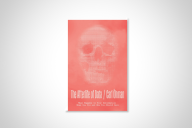You have /5 articles left.
Sign up for a free account or log in.
I fell in love with the grand reading room of the 42nd Street branch of the New York Public Library long before ever setting foot in the place. The occasion was Damon Knight's Charles Fort: Prophet of the Unexplained, the first biography of America’s great chronicler of strange phenomena.
Fort, who died in 1932, tirelessly collected reports of spontaneous teleportation, poltergeists, downpours of frogs (the one in the film Magnolia is a nod to Fort) and mysterious objects hovering in the pre-Wright Brothers sky. He wrote about them with tongue in cheek, to mock scientific confidence in the fundamental rationality of the universe. It would be fair to call him a surrealist historian. Fort’s irony went right by me at the age of 12, but I had a typical prepubescent interest in the paranormal (fueled in part by rumors that The Exorcist was so scary that it had actually killed members of the moviegoing public or driven them insane) and Fort’s biography was shelved somewhere along that stretch of the Dewey decimal system.
Fort's interest in anomaly notwithstanding, it was Knight’s description of an ordinary scene in the eccentric writer’s daily life that burned itself into my memory as vividly as any episode of Kolchak: The Night Stalker. The passage is bit long, but as the evocation of a place and a mood it is magnificent:
“In the reading room of the New York Public Library, that mausoleum, designed by some schoolmaster with memories of hard oak, dust and gloom, there are men who sit day after day, bulwarked by stacks of books, scribbling, scribbling in the little pools of light from the green-shaded lamps on the long oak tables, and you look at them and wonder what will-o’-the-wisps they are pursuing day after day, year after year. One of them may be writing a history of dentistry in America, another studying explosives in order to blow up the world, a third gathering evidence that Shakespeare wrote the Bible. Their faces are pale and grim. The only cheerful people in that place are those who do not read the books, but only handle them as they come from the dumbwaiter, and set them on the counter like mouldy slabs of beef. Those who sit at the long tables day after day are dedicated men; some of them are brave men. There is death in old books from the stacks of a great library; the dust that impregnates their pages is death and darkness; the dust says, These are books that no one has opened for twenty years, fifty years, eighty years; and when you have written your book, it too will gather dust. White book dust, bone dust: garden dirt and axle grease are clean in comparison; they are living and unctuous; rubbed into the skin, they do good. The dust of books causes blains and hangnails; ingested, it provokes dyspepsia, flatulence, and heartburn; in the lungs it is cancerous. Who would not choose, if he could, to sit chained to an oar in a Roman galley, in the sunlight and salt air, rather than in this sunless crypt where, in the years from 1905 to 1920, Charles Fort sat? Many people must have wondered why he was here behind his tall stack of books: but one does not ask. Perhaps there is another like him there today, silent and determined under the green-shaded lamp.”
Finally able to do research there 20 years later, I was disappointed to find the main reading room somewhat less gloomy than depicted. (A later visit to the manuscript archive proved more satisfactory on that score.) I was there on a hunch that there might be a review of C. L. R. James’s World Revolution in a Canadian Marxist splinter group’s newspaper from the 1930s, as indeed there was. Knight was right about dust -- the brittle paper flaked with every turn of the page. It was an experience of deep connection, both with the history I was there to study and with the countless geniuses and cranks who had worked at the reading room’s long tables down the many years.
In 2012 it looked for a while as if Fort’s specter might end up homeless. Efforts were afoot to transform the library -- to remove books from the shelves in its vast basement and send them to New Jersey, and replace the reading room itself with something more cheerful and revenue enhancing. A tourist-friendly spot, where you could get a coffee, perhaps, and check your email.
Plans to renovate the 42nd Street library only became public knowledge when Scott Sherman revealed it in a cover story for The Nation, where he is a contributing writer. Following his lead on the story, I wrote this column on the impending disaster. Anthony Marx, the library’s president, responded with an article designed to mollify scholars -- who, as my reply indicated at the time, were not falling for it.
The more the word got around, the greater the outcry. There were letters. There were petitions. The library was flash-mobbed by a group called Books Not Billionaires. The architecture critic for The New York Times weighed in on the plan and found it wanting, not to say atrocious. By May 2014, the plan was dead.
Now in Sherman’s book, Patience and Fortitude: Power, Real Estate, and the Fight to Save a Public Library, published by Melville House, we have the full story -- or as much of it as can be told at this time, given the refusal of some parties to be interviewed. The title might sound a little bit portentous, but it isn’t: Patience and Fortitude are the two famous marble lions outside the library’s main entrance. The sculptor did not christen them. The names are part of the building’s lore, coined by Mayor Fiorello LaGuardia and adopted by patrons.
Sherman’s deeply researched but swiftly paced account of the rise and fall of the Central Library Plan (as it was called) doubles as a record of how deeply the institution became rooted in the city’s history and folkways since it opened its doors in 1911. None of which, it seems, counted for much in the scheme that was in place on the library’s centenary.
From thousands of pages of documents he obtained under New York’s Open Meetings Law, the author reports that the CLP, “conceived in the boom years preceding the recession of 2008, was a mystifying combination of austerity and devil-may-care overreach” that “was pushed along, in absolute secrecy, not by professional librarians but by a tight, core group of wealthy trustees from the worlds of finance and real estate.”
Sherman credits the trustees with having had good intentions, but it is worth stressing that he found none of the pseudopopulist rhetoric about “democratizing the library” during the planning phase. That was secreted only when necessary, like ink from a frightened squid. Once details of the plan were made public and subject to debate, the rationalizations collapsed -- as the 42nd Street structure itself might have, given the deep architectural flaws in the proposed renovation.
Patience and Fortitude makes clear that if the library had a golden age (a decade or so on either side of World War II, by the author’s reckoning) it has nonetheless had a long history of fiscal turmoil, and of leadership that was better suited to facing the challenges before it at some times than at others. What became an issue for the first time only in the most recent crisis was the fundamental understanding of the 42nd Street library as a world-renowned cultural institution that occupies some prime real estate, rather than the emphasis being the other way around.
Stone lions alone cannot defend such a unique location. Patience and Fortitude show how writers, teachers, students and scholars intervened before things reached the point of no return. Scott Sherman’s book is certain to find appreciative readers, because it is one for readers, who desperately need an advocate once the money starts talking.








